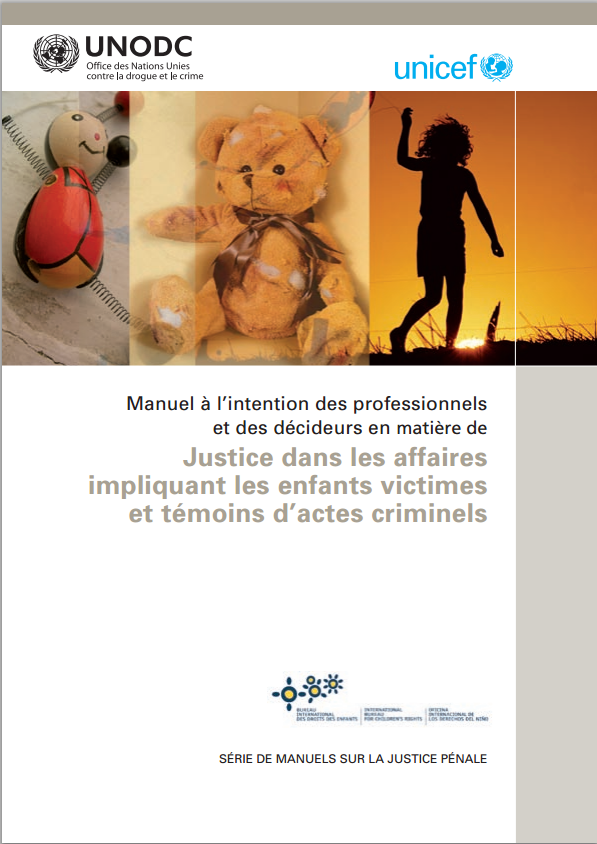The Guidelines on Justice for Child Victims and Witnesses of Crime

While the rights of accused and convicted persons must be safeguarded, every child has the right to have his or her best interests taken into account as a matter of priority, which includes the right to protection and the opportunity for harmonious development.
One of the cross-cutting principles of the Guidelines on Justice for Child Victims and Witnesses of Crime adopted by the United Nations Economic and Social Council in its resolution 2005/20 of 22 July 2005
Duration of the project : 2000-2005
Shortly after its creation, the International Bureau for Children's Rights established the International Tribunal for Children's Rights to investigate and propose concrete solutions to violations of children's rights. Early work on the issues of sexual exploitation of children highlighted the gaps in the consideration of child victims and witnesses in criminal justice proceedings. This led to the documentation of good practices, analysis of relevant international, regional and national instruments, and consultations and dialogues with members of governments, non-governmental organisations (NGOs), professionals and experts in child law, criminal law, criminology and victimology.
The Guidelines on Justice for Child Victims and Witnesses of Crime, developed by the IBCR, are the result of this careful and innovative review. Since their adoption by the United Nations in 2005, they have become an international standard for ensuring that the rights of child victims and witnesses of crime are respected and addressed.
The objectives of the project :
The guidelines present established good practice and provide the framework for achieving the following objectives :
- To assist States in reviewing their national laws, procedures and practices to ensure full respect for the rights of child victims and witnesses of crime;
- To assist governmental and non-governmental organisations, international bodies and all interested actors in the development and implementation of legislation, policies, programmes and practices on issues relating to child victims and witnesses of crime
- To guide professionals and/or volunteers working with child victims and witnesses of crime in their daily practice and support them in their role as caregivers
In doing so, respect for the cross-cutting principles that animate the guidelines is fundamental: dignity, non-discrimination, the best interests of the child (protection and harmonious development) and the right to participation. The guidelines therefore recall the rights of the child in the context of his or her participation in the criminal justice process. The tripartite agreement between the United Nations Office on Drugs and Crime (UNODC), UNICEF and the IBCR has subsequently led to the creation of various popularisation documents on the Guidelines, such as the child-friendly version, the model law and commentary, the implementation guide and training tools.
1. The right to be treated with dignity and compassion
2. The right to be protected from discrimination
3. The right to be informed
4. The right to express opinions and concerns and to be heard
5. The right to effective assistance
6. The right to privacy
7. The right to be protected from any harm that may be caused by the justice process
8. The right to safety
9. The right to reparation
10. The right to special preventive measures
- Intervention locations : Worldwide
- Project duration: 2000 - 2005
- Partners :
- Intergovernmental group of fifty (50) experts from twenty-nine (29) countries
- United Nations Children's Fund (UNICEF)
- United Nations Office on Drugs and Crime (UNODC)
- United Nations Economic and Social Council (ECOSOC)
- Department of Justice Canada
- Highlights:
- Publication in 2001 of the report Selected best practices and protocols used around the world regarding the needs of child victims and witnesses of crime in the criminal justice system
- Adoption of the Guidelines by the United Nations Economic and Social Council (ECOSOC) in 2005 on the recommendation of the United Nations Commission on Crime Prevention and Criminal Justice
- Progressive translation of the guidelines into seven languages (Arabic, Chinese, English, French, Russian, Slovak and Spanish) until 2009
- Publication in 2004-2005 of the guidelines as a CD-ROM in Europe by the Victims of Terrorism Foundation in collaboration with the Bureau, the World Society of Victimology and the Victimologia Foundation
- Fields of activity and expertise :
- Applied research
- Children in emergency situations
- Child sexual exploitation
- Children and the justice system









